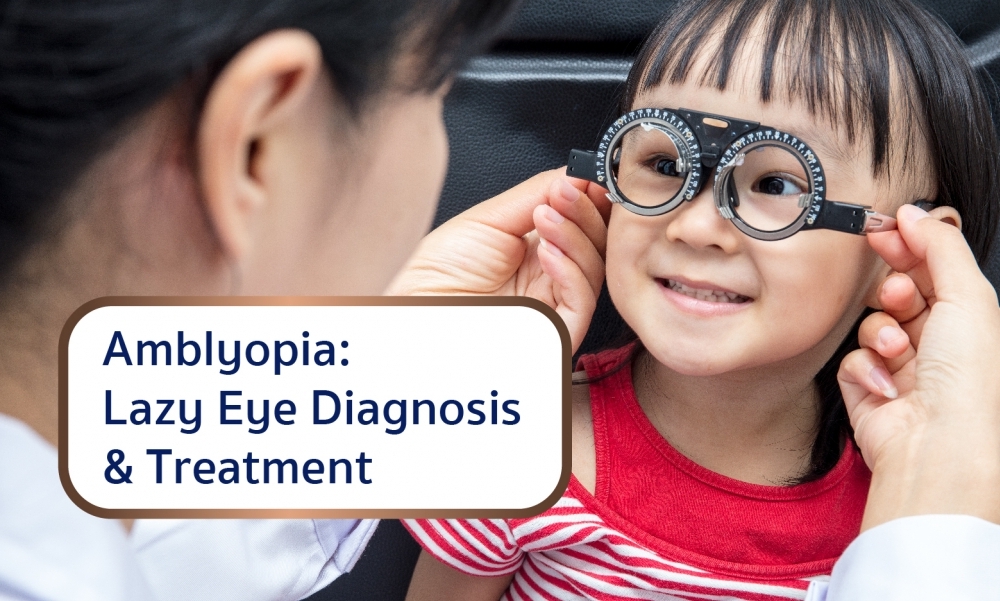Your child might not be aware of having better vision in one eye than the other. And you may not realize it either unless your child has strabismus or another eye problem you can see.
Amblyopia Diagnosis
The ophthalmologist will do a complete medical eye exam, looking for eye problems that could be affecting vision.
Poor vision in one eye does not always mean a child has amblyopia. In some cases, wearing glasses to correct a refractive error in one eye can improve vision.
When Should a Child's Vision Be Tested?
All children should have their vision checked by their pediatrician or ophthalmologist at or before their 4th birthday. If there is a family history of misaligned eyes, childhood cataracts or serious eye disease, an ophthalmologist should check their eyes when they are an infant.
Amblyopia Treatment
Amblyopia is usually corrected by making the child use their weaker eye. This is often done by putting a patch over the child’s stronger eye. In some cases, eye drops can be used to blur vision in the stronger eye. Or the child may wear eyeglasses with a lens that blurs vision in that eye.
It generally takes several weeks to several months to strengthen vision in the weaker eye. Once the child has better vision in that eye, they may need to wear an eye patch part-time for a few years. This is because there is a chance that eye can weaken again. Remember to keep all appointments with the child’s ophthalmologist who will carefully monitor your child’s vision.
How to Choose and Use an Eye Patch
An eye patch should be comfortable, yet remain firmly in place. It should also not allow the child to peek around its edges.
If your child wears glasses, there are patches designed to attach to the lens. These may be good for children who are used to wearing a patch, but they are not as good for a child new to treatment. This is because the patch can slip or the child may learn to peek around it. If your child wears glasses and is not used to patching, it is best to attach the patch directly around the stronger eye underneath the glasses.
Keep Your Child from Taking Off the Eye Patch
Children do not like to have their stronger eye patched or blurred. However, you need to help your child do what is best for them. Otherwise, treatment will not work.
It can take a while for your child to get used to wearing a patch. Over time, this should get easier for them and you. Remember that strengthening the weaker eye is the only way to develop healthy, normal vision.
If your child still takes off the patch, as a last resort, you might cover his or her hands with gloves, mittens, or socks.
Teach Your Child About the Eye Patch
Pre-school or school-age children might not want to wear an eye patch or use blurring eye drops. To help, parents should explain how important these treatments are to be able to see well. And reassure them that lots of children wear eye patches for the same reason.
Explain the amblyopia treatment to the child’s teacher. Ask the teacher to compliment the child on being so good about wearing the patch. Children thrive on positive feedback from their teachers.
Things to consider with patching treatment:
In very rare instances it is possible to overuse the patch or blurring eye drops. This can affect vision in the stronger eye. Be sure to keep the child’s appointments with the ophthalmologist so that vision in both eyes can be closely monitored.
The skin near your child’s eye patch can get irritated. To help, try a different size or type of patch, and angle the patch differently each day.
Your child may initially be clumsy when wearing a patch. Try to keep an eye on your child when they are climbing stairs or being active.
Surgery to Correct Causes of Amblyopia
In some cases, the ophthalmologist will recommend surgery to correct certain eye problems causing amblyopia. After surgery, the child may need to keep wearing a patch or otherwise cover the stronger eye until his or her vision improves.
It is possible to prevent vision loss from amblyopia. But treatment only works if your child only uses the weaker eye to see.
Treating Amblyopia for Better Lifelong Vision
When a child has amblyopia, it is important to make vision stronger in the weak eye. Even if eye problems causing amblyopia are corrected with glasses or surgery, the amblyopia itself must be treated. If not, the child may have lifelong vision problems.
Article from American Academy of Ophthalmology
 02-056-3333
02-056-3333





